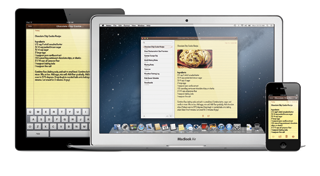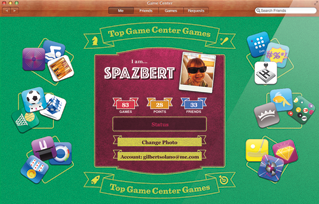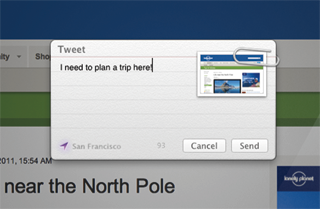Another Mountain Lion feature, Documents in the Cloud, introduces something that you might guess Macs would already have: The ability to use iCloud to seamlessly share files with iOS devices in such cross-platform apps as Apple’s Pages, Numbers and Keynote.
Until now, it was easy to use iCloud to move documents you created on an iPhone or iPad onto a Mac, but reversing the process required you to futz with iTunes or upload files to Apple’s iWork.com service. Documents in the Cloud will eliminate the futzing and manual uploading: You’ll be able to get to all your documents in one place on any Mac or iOS device, and the edits you make will be reflected everywhere. (The developer preview provides just a hint of all this: Right now, it works only with Preview and Text Edit, two OS X apps that aren’t even available for iOS.)

Apple
iCloud also powers two new OS X apps based on iOS ones, Reminders and Notes. Both give you exactly the features their names suggest, and both use iCloud to sync data with any iPhone, iPad or other Mac you happen to own. Neither program is exactly bursting with features, and third-party apps such as Simplenote and Remember the Milk already work across multiple devices. Still, it’s nice to see them as standard OS X equipment.

Apple
Game fans should also be pleased by the arrival of yet another iOS feature in OS X: Game Center. As on the iPhone and iPad, it lets you find folks to compete against and share your scores and achievements. Most tantalizingly, it will allow developers to create multi-player, cross-platform games. That opens up the possibility, for instance, of a racing game that doesn’t care whether drivers are using a Mac, an iPhone or an iPad.
In iOS 5, Apple built social plumbing directly into the operating system, and it did it in an interesting way: It integrated support for Twitter. (Twitter may have gotten the nod at least in part because of Apple’s reportedly prickly relationship with Facebook.) Mountain Lion adds similar Twitter-everywhere capabilities to OS X: Using a simple Tweet Sheet, you can tweet right from Safari, Preview, iPhoto and other programs.

Apple
Tweet Sheets are one flavor of Share Sheets, which let you share stuff by a variety of means within OS X programs. The exact lineup of Share Sheets varies from app to app: In Photo Booth, for instance, they let you distribute your photographic creations using e-mail, Messages, Twitter, Flickr and OS X’s AirDrop wireless file-transfer utility.
AirPlay Mirroring, yet another Mountain Lion feature borrowed from iOS, isn’t working in the developer preview, but it looked especially nifty when Apple gave me a demo. It lets you wirelessly beam your Mac’s display, in 720p HD resolution, onto an HDTV or computer display equipped with Apple’s $99 Apple TV box. At home, this will be a convenient way to watch a movie from iTunes or play a game on the biggest screen in the house; at work, it’ll allow you to conduct a presentation without futzing with cables.
Products and technologies such as Intel’s Wireless Display and Veebeam already permit similar wireless transmission of a computer’s display to a TV. This is, however, the first time the concept has been built right into an operating system, and it should make Apple TV that much more appealing.
One major new feature in OS X 10.8, Gatekeeper, shows no iOS influence. It’s a set-it-and-forget-it option that lets you control what type of programs are allowed on your Mac. You can choose to allow only ones that Apple has vetted and distributed through the Mac App Store. You can permit both App Store software and programs which have been signed with a Developer ID, which indicates that the software in question hasn’t been tampered with and doesn’t carry any malware. (That’s the default setting.) Or you can throw caution to the wind and let OS X install any program–from the App Store or elsewhere, signed or unsigned.
So that’s Mountain Lion–or at least the early version that Apple is letting developers try. (The company could be holding back some surprises to announce when the products nears general availability: Wouldn’t it be cool if OS X got its own version of the iPhone 4S’s Siri?) I did notice a few other enhancements that Apple isn’t trumpeting, such as the way the Safari browser finally does away with a separate search field in favor of a unified address bar that can handle both URLs and searches. But large swaths of the operating system and its bundled apps haven’t changed a bit.
(MORE: 50 Best iPhone Apps)
For now, the single best thing about Mountain Lion isn’t any one particular feature. Instead, it’s the impressive degree to which Apple is opening up the upgrade’s goodness to third-party developers. They can write programs that display notifications; they’ll be able to uses Share Sheets and Documents in the Cloud; their games can hook into Game Center. Judging from how quickly new iOS features show up in third-party apps, I’m optimistic that many Mac apps will get on board.
Apple products have always had a reputation for working best when you use them together. With its pervasive links to iOS and iCloud, Mountain Lion will take that truism to a new level. It may not be an entirely new breed of cat, but if it sells for the same price that Lion did–a measly $29–it should make a lot of Mac fans very happy.


